Related Research Articles
"4th Time Around" is a song by American singer-songwriter Bob Dylan, which was released as the 12th track on his seventh studio album Blonde on Blonde on June 20, 1966. The song was written by Dylan and produced by Bob Johnston. Commentators often interpret it as a parody of the Beatles' 1965 song "Norwegian Wood ". John Lennon composed "Norwegian Wood" after being influenced by the introspective lyrics of Dylan. Lennon later reflected on his feelings of paranoia when Dylan first played him "4th Time Around".
"Sad Eyed Lady of the Lowlands" is a song by the American singer-songwriter Bob Dylan. First released as the final track on Dylan's seventh studio album, Blonde on Blonde (1966), the song lasts 11 minutes and 23 seconds, and occupies the entire fourth side of the double album. The song was written by Dylan and produced by Bob Johnston. The recording session began at 6 pm on February 15, 1966, at Columbia Studio A, Nashville, Tennessee, but Dylan worked on the lyrics for several hours while the experienced Nashville session musicians hired to accompany him stood by. Four takes were recorded in the early hours of February 16; the final recording was released on Blonde on Blonde. The music is a waltz in 6/8 time.
"Absolutely Sweet Marie" is a song by American singer-songwriter Bob Dylan, which was released on the third side of the double album and Dylan's seventh studio album, Blonde on Blonde (1966). The song was written by Dylan and produced by Bob Johnston. It was recorded at around 1:00 am on March 8, 1966, at Columbia Studio A, Nashville. Some commentators have interpreted the song as being about sexual frustration.
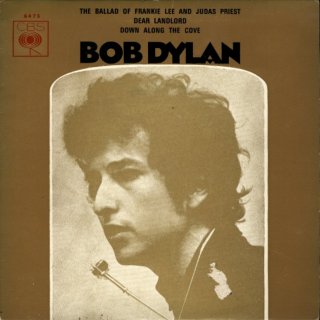
"The Ballad of Frankie Lee and Judas Priest" is a song by American singer-songwriter Bob Dylan. It was released as the fifth track on his eighth studio album John Wesley Harding (1967). The track was written by Dylan and produced by Bob Johnston. It was recorded in one take on October 17, 1967, at Columbia Studio A in Nashville. The song's lyrics refer to two friends, Frankie Lee and Judas Priest. Lee asks Priest for a loan of money and Priest offers it freely. Lee spends it in a brothel over 16 days, then dies of thirst in Priest's arms. It has been suggested by commentators that the song refers to Dylan's relationship with his manager Albert Grossman or to his contractual negotiations with his record company. The song received a largely negative critical reception. Dylan has performed the song live in concert 20 times, from 1987 to 2000.
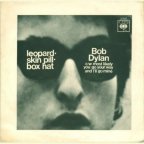
"Leopard-Skin Pill-Box Hat" is a song by American singer-songwriter Bob Dylan, which was released on the second side of his seventh studio album Blonde on Blonde (1966). The song was written by Dylan, and produced by Bob Johnston. Dylan has denied that the song references any specific individual, although critics have speculated that it refers to Edie Sedgwick, who Dylan had spent time with in December 1965.
"Tombstone Blues" is a song by American singer-songwriter Bob Dylan, which was released as the second track on his sixth studio album Highway 61 Revisited (1965). The song was written by Dylan, and produced by Bob Johnston. Critical interpretations of the song have suggested that the song references the Vietnam War and US President Lyndon Baines Johnson.

"Stuck Inside of Mobile with the Memphis Blues Again" is a song by American singer-songwriter Bob Dylan from his seventh studio album, Blonde on Blonde (1966). The song was written by Dylan and produced by Bob Johnston. It has nine verses, each featuring a distinct set of characters and circumstances. All 20 takes of "Stuck Inside of Mobile with the Memphis Blues Again" were recorded in the early hours of February 17, 1966, at Columbia Records's A Studio in Nashville, Tennessee, with the last take selected for the album. This version also appears on Dylan's second compilation album, Bob Dylan's Greatest Hits Vol. II (1971).

"Just Like a Woman" is a song by American singer-songwriter Bob Dylan from his seventh studio album, Blonde on Blonde (1966). The song was written by Dylan and produced by Bob Johnston. Dylan allegedly wrote it on Thanksgiving Day in 1965, though some biographers doubt this, concluding that he most likely improvised the lyrics in the studio. Dylan recorded the song at Columbia Studio A in Nashville, Tennessee in March 1966. The song has been criticized for supposed sexism or misogyny in its lyrics, and has received a mixed critical reaction. Some critics have suggested that the song was inspired by Edie Sedgwick, while other consider that it refers to Dylan's relationship with fellow folk singer Joan Baez. Retrospectively, the song has received renewed praise, and in 2011, Rolling Stone magazine ranked Dylan's version at number 232 in their list of the 500 Greatest Songs of All Time. A shorter edit was released as a single in the United States during August 1966 and peaked at number 33 on the Billboard Hot 100. The single also reached 8th place in the Australian charts, 12th place on the Belgium Ultratop Wallonia listing, 30th in the Dutch Top 40, and 38th on the RPM listing in Canada.

"Rainy Day Women #12 & 35" is a song written and recorded by American singer-songwriter Bob Dylan. Columbia Records first released an edited version as a single in March 1966, which reached numbers two and seven in the US and UK charts respectively. A longer version appears as the opening track of Dylan's seventh studio album, Blonde on Blonde (1966), and has been included on several compilation albums.

"I Want You" is a song by American singer-songwriter Bob Dylan, which was released as a single in June 1966, and, later that month, on his seventh studio album, Blonde on Blonde. The song was written by Dylan, and produced by Bob Johnston. The song has been interpreted as a straightforward expression of lust, although critics have highlighted that the symbolism of the song is complex. It was the last song recorded for Blonde on Blonde, with several takes recorded in the early hours of March 10, 1966. It was included on Bob Dylan's Greatest Hits (1967). The song has received a largely positive critical reception, with a number of commentators highlighting Dylan's use of imagery, although some of the meanings are obscure.
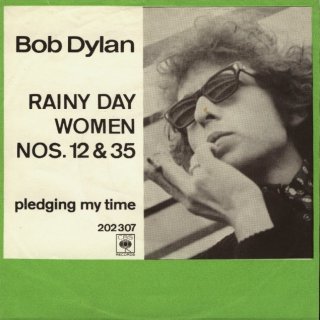
"Pledging My Time" is a blues song by American singer-songwriter Bob Dylan from his seventh studio album, Blonde on Blonde (1966). The song, written by Dylan and produced by Bob Johnston, was recorded on March 8, 1966 in Nashville, Tennessee. Dylan is featured on lead vocals, harmonica, and guitar, backed by guitarist Robbie Robertson and an ensemble of veteran Nashville session men.
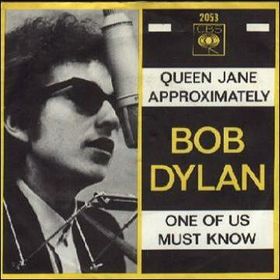
"One of Us Must Know (Sooner or Later)" is a song by American singer-songwriter Bob Dylan, which was released as a single on February 14, 1966, and as the fourth track on his seventh studio album Blonde on Blonde in June of that year. The song was written by Dylan and produced by Bob Johnston. It is the narrator's account of a burned-out relationship. It was recorded at Columbia studio A in New York on January 25, 1966, with Dylan and other musicians developing the song through over twenty takes during the session.
"To Ramona" is a song by American singer-songwriter Bob Dylan, first released on his fourth studio album, Another Side of Bob Dylan (1964). The song was written by Dylan, and produced by Tom Wilson. The lyrics were started at the May Fair Hotel in London in May 1964, and finished during a week-long stay in the Greek village of Vernilya later that month. Dylan recorded all the tracks for the album, including the song, in a single three-hour session on June 9, 1964, at Studio A, Columbia Recording Studios, New York. Its narrator advises Ramona, who is preparing to return to "the South", not to follow the advice of others. Critics have suggested several different people as inspirations for the song, including Joan Baez, Suze Rotolo, and Sara Lownds.
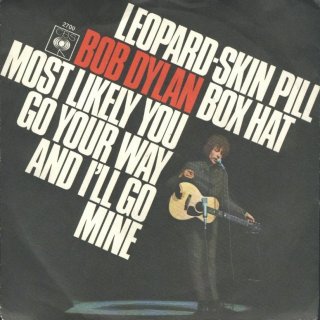
"Most Likely You Go Your Way and I'll Go Mine", or "Most Likely You Go Your Way (and I'll Go Mine)", is a song by American singer-songwriter Bob Dylan. It was released as the first track on side three of his seventh studio album Blonde on Blonde (1966). The song was written by Dylan and produced by Bob Johnston. Dylan recounted that he had probably written the song after the end of a relationship. The song's narrator criticizes the lies and weakness of a woman, and says that he finds it hard to care. The final verse establishes that the woman has been unfaithful to the narrator by having a relationship with another man, as he suspected all along.
"John Brown" is a song by American singer-songwriter Bob Dylan. The song, written in October 1962 was released under his pseudonym "Blind Boy Grunt" on the Folkways Records compilation album Broadside Ballads, Vol. 1 (1963). Live performances have been officially released on MTV Unplugged (1995), Live at The Gaslight 1962 (2005), and Live 1962–1966 – Rare Performances From The Copyright Collections (2018). A demo version was issued on The Bootleg Series Vol. 9 – The Witmark Demos: 1962–1964 (2010).
"Where Are You Tonight? " is a song by American singer-songwriter Bob Dylan, which was released as the closing track on his 18th studio album Street-Legal (1978). The song was written by Dylan, and produced by Don DeVito. Dylan has said that the song is about the individual's "enemy within." Critical interpretations of the song have suggested that it references Dylan's divorce as well as foreshadowing or announcing his conversion to Christianity, which became evident in the religiously-focused projects that followed the album. Commentators have also opined that there are allusions in the lyrics to the work of Robert Johnson.

"Obviously 5 Believers" is a song by American singer-songwriter Bob Dylan, which was released as the last track of side three of his double album Blonde on Blonde (1966), and was the B-side to the single release of "Just Like a Woman" for releases in America and some other countries. The song was written by Dylan and produced by Bob Johnston. It was recorded at Columbia Music Row Studios, in the early morning hours of a March 9–10, 1966 session. Four takes were recorded, although the first two were incomplete. It has been interpreted as a blues song about loneliness, with critics noting similarities in melody and structure to Memphis Minnie's "Chauffeur Blues". Dylan's vocals and the musicianship of the band on the track have both received critical acclaim, although the track has been regarded as insubstantial by some commentators.
"You're No Good" is a song by Jesse Fuller that appeared as the opening track on Bob Dylan's eponymous debut album (1962). Eight takes were recorded by Dylan on November 20, 1961. He learnt the song directly from Fuller in Denver; Fuller's own recorded version was not released until May 13, 1963, on his album San Francisco Bay Blues. The song concerns the narrator's difficult relationship with a woman, and concludes with the narrator wanting to "lay down and die". Dylan's version is more uptempo than Fuller's, and has some changes to the lyrics; it has been positively reviewed by critics.
"Highway 51 Blues" is a song composed by American blues pianist Curtis Jones, released on a 78 record on January 12, 1938. Bob Dylan's track "Highway 51", released as the closing track of the first side of his debut album Bob Dylan on March 19, 1962, incorporated the tune from Jones's version.
"I Shall Be Free No. 10" is a song by American singer-songwriter Bob Dylan, which was released as the fifth track on his fourth studio album Another Side of Bob Dylan (1964). The song was written by Dylan and produced by Tom Wilson. The song is a humorous talking blues, indebted to earlier songs including Lead Belly's "We Shall Be Free". Dylan opens the song by proclaiming that he is normal and average, but then acknowledges his reputation by singing the self-aware doggerel "Yippee! I'm a poet, and I know it/ Hope I don't blow it".
References
- ↑ Heylin 1995, pp. 45–53.
- ↑ Heylin 2010, pp. 325–326.
- ↑ Sanders 2020, pp. 52–52.
- 1 2 Sanders 2020, p. 52.
- 1 2 3 4 Margotin & Guesdon 2015, p. 235.
- ↑ Sanders 2020, p. 99.
- ↑ Björner, Olof. "Still on the Road: 1966 Blonde on Blonde Recording Sessions and World Tour". bjorner.com. Archived from the original on October 26, 2019. Retrieved May 2, 2020.
- ↑ Sanders 2020, p. 223-224.
- 1 2 3 4 "Temporary Like Achilles". Sony Music Entertainment. Archived from the original on November 30, 2022. Retrieved November 30, 2022– via bobdylan.com.
- 1 2 3 4 Gill 2011, pp. 148–149.
- ↑ Sanders 2020, p. 224.
- ↑ Heylin 2016, 7290: a Sony database of album release dates ... confirms once and for all that it came out on June 20, 1966"..
- 1 2 Nogowski 2022, p. 61.
- 1 2 Nogowski 2022, p. 375.
- ↑ Harrington, Richard (February 10, 1995). "CD-ROM boasts treasure trove of Dylan material". Indianapolis News . p. 32.
- 1 2 Shelton 1987, p. 324.
- ↑ "Doors keyboardist an echo fan". Fort Lauderdale News . Fort Lauderdale. October 2, 1987. p. 20.
- ↑ Bream, Jon (May 23, 1991). "Bob Dylan:a golden oldie". Star Tribune . Minneapolis. p. 1E,3E.
- ↑ Williamson, Lori (May 24, 2011). "Bob Dylan's Lyrics for Temporary Like Achilles". Minnesota Historical Society. Archived from the original on July 24, 2019. Retrieved August 8, 2020.
- 1 2 Starr 2021, 1445.
- 1 2 Hartman 2015, p. 749.
- ↑ Heylin 2010, pp. 121–127.
- 1 2 Sanders 2020, p. 223.
- ↑ White, Anna (February 8, 2017). "New lyrics incorporate classics". The Falcon. Seattle: Seattle Pacific University.
- ↑ Strunk 2009, pp. 119–136.
- ↑ Dylan, Bob (June 5, 2017). "Bob Dylan – Nobel Lecture". Nobel Foundation. Archived from the original on August 14, 2020. Retrieved August 10, 2020.
- ↑ Cyrino 1998, p. 226.
- ↑ Ward 2004, p. 261.
- ↑ McGregor, Craig (October 8, 1966). "Pop scene". The Sydney Morning Herald . Sydney. p. 19.
- ↑ "LP reviews: Blonde on Blonde" (PDF). Beat Instrumental . September 1966. p. 21. Archived (PDF) from the original on December 12, 2022. Retrieved January 22, 2023.
- ↑ Jopling, Norman (August 13, 1966). "Bob Dylan: Blonde On Blonde (CBS)". Record Mirror . London. Archived from the original on August 11, 2020. Retrieved August 8, 2020.
- ↑ Trager 2004, p. 609.
- ↑ Sanders 2020, pp. 223, 278.
Citations
Journal articles
- Cyrino, Monica Silveira (1998). "Heroes in D(u)ress: Transvestism and power in the myths of Herakles and Achilles". Arethusa . 31 (2). Johns Hopkins University Press: 207–41. doi:10.1353/are.1998.0008. JSTOR 26309722. S2CID 162921909. Archived from the original on November 10, 2022. Retrieved November 10, 2022.
- Hartman, Charles O. (2015). "Dylan's Bridges". New Literary History . 46 (4). Johns Hopkins University Press: 737–57. doi:10.1353/nlh.2015.0037. S2CID 163223965.
- Strunk, Thomas E. (2009). "Achilles in the Alleyway: Bob Dylan and Classical Poetry and Myth". Arion: A Journal of Humanities and the Classics . 17 (1). Trustees of Boston University: 119–136. doi:10.1353/arn.2009.0027. S2CID 191840957. Archived from the original on January 22, 2023. Retrieved August 9, 2020.
- Ward, Geoff (2004). "Review: Bob Dylan Among the Professors". The Cambridge Quarterly . 33 (3). Oxford University Press: 261–269. Archived from the original on January 22, 2023. Retrieved August 9, 2020.
Books
- Gill, Andy (2011). Bob Dylan: the stories behind the songs 1962–1969. London: Carlton. ISBN 978-1-84732-759-8.
- Heylin, Clinton (1995). Dylan: Behind Closed Doors – the Recording Sessions (1960–1994). Penguin Books. ISBN 978-0-14-025749-6.
- Heylin, Clinton (2010). Revolution in the Air – the songs of Bob Dylan Vol.1 1957–73. Constable & Robinson. ISBN 978-1-84901-296-6.
- Heylin, Clinton (2016). Judas! (Kindle ed.). Ponteract: Route. ISBN 978-1-944713-30-0.
- Margotin, Philippe; Guesdon, Jean-Michel (2015). Bob Dylan All the Songs: The Story Behind Every Track. New York: Black Dog & Leventhal. ISBN 978-1-57912-985-9.
- Nogowski, John (2022). Bob Dylan: A Descriptive, Critical Discography and Filmography, 1961-2022 (3rd ed.). Jefferson: McFarland & Company. ISBN 978-1-4766-4362-5.
- Sanders, Daryl (2020). That Thin, Wild Mercury Sound: Dylan, Nashville, and the Making of Blonde on Blonde (epub ed.). Chicago: Chicago Review Press. ISBN 978-1-61373-550-3.
- Shelton, Robert (1987). No Direction Home: the Life and Music of Bob Dylan. London: New English Library. ISBN 978-0-450-04843-2.
- Starr, Larry (2021). Listening to Bob Dylan. Music in American Life (Kindle ed.). Urbana: University of Illinois Press. ISBN 978-0-252-05288-0.
- Trager, Oliver (2004). Keys to the Rain: the Definitive Bob Dylan Encyclopedia. New York: Billboard Books. ISBN 978-0-8230-7974-2.